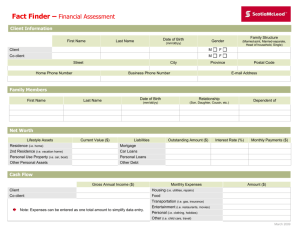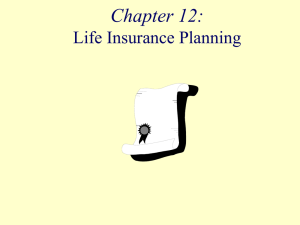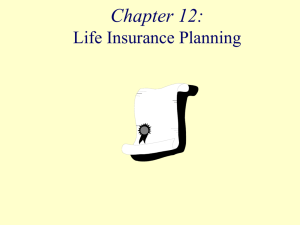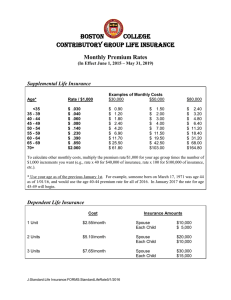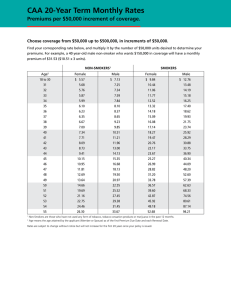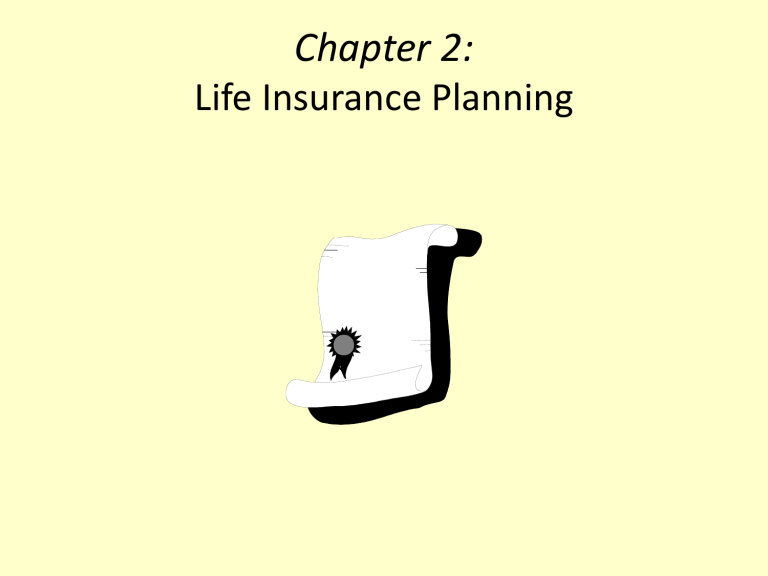
Chapter 2: Life Insurance Planning Objectives • Identify the purpose of life insurance and the reasons for buying it. • Recognize that the need for life insurance varies over the course of one’s life and identify the procedures used to calculate life insurance needs. Objectives • Distinguish among the various types of term and cash-value life insurance policies. • Describe and explain the purpose of the major provisions of life insurance policies. • Discuss important points to consider when choosing and buying life insurance. What is the Purpose of Life Insurance? • To protect people who depend on you from financial loss related to your death – 78% of all American households have it • To make charitable bequests upon your death • To save money for retirement or children’s education • To leave as part of your estate • To pay off a mortgage or other debts at the time of death The Principle of Life Insurance • Mortality tables provide odds on your dying, based on your age and sex • Your premium is based on the projections for the payouts for persons who die Determining Your Life Insurance Needs - Ask Yourself... • Do you need life insurance? – do you have people you need to protect financially? – does your partner work? • What are your objectives for life insurance? – to accumulate money for retirement? – to provide funds when you die? – how much can you afford? Estimating the Amount of Life Insurance You Need The Easy Method – typically, you will need to have enough insurance to cover 70% of your income for seven years The DINK (dual income, no kids) Method The “Nonworking” Spouse Method The “Family Need” Method looks at – employer provided insurance – Social Security benefits – income and assets Determining Life Insurance Needs 1. Multiple-of-Earnings Approach • The simplest method for estimating your clients’ life insurance needs is the multiple-of-income approach. The goal of this approach is to replace the primary breadwinner’s salary for a predetermined number of years. • Begin by multiplying the client’s current annual income by how many years they want to provide financial support for their survivors. The recommendation is to have seven to ten years of life insurance. • It’s an easy method, but it doesn’t take into account the specific needs of survivors, other sources of funds — such as the survivors’ income and investments — or different types of family structures. For example, this method may work well for a family with one child, but might not work as well for a family with six children. It also doesn’t take into account inflation or future salary increases. Using this approach may lead to overinsuring or underinsuring your clients, but it’s a start Human Life Value Approach • This method considers your client’s age, gender, occupation, current and future earnings, and employee benefits. There are several steps to determining the overall value of the client if they were to die today: • Estimate the client’s earnings from now until a set point in the future — typically their expected retirement age. Be sure to factor in future wage increases as well. • Subtract the insured’s annual taxes and living expenses from the total. It’s usually safe to assume 30 percent of their salary will go to taxes. • Select an assumed rate of return on the remaining total and subtract it from the gross amount. In other words, subtract the interest you expect the money to earn. • Add the cost of additional benefits provided through employment, such as health care, that will need to be replaced when the client dies. Remember to account for inflation. • The primary goal of this method is to replace income lost. It doesn’t necessarily account for funeral costs, children’s educational expenses, or other specific future needs. Capital Need Approach • The capital needs analysis is the most widely-used approach for estimating life insurance coverage. In addition to replacing the client’s salary, it also accounts for other sources of income and the specific needs of survivors. • This method factors in: • Current and future income of both the insured and surviving spouse • Immediate lump-sum cash needs upon death, such as funeral expenses, debt repayment, and mortgage payoff • Future expenses such as college, weddings, long-term care expenses, and retirement funding • Existing family assets, retirement funds, or insurance policies • Once all future needs are taken into consideration, there are then two ways to calculate how much insurance the client needs, based on how they want to utilize the funds in the future. • Earnings-Only Approach: The survivors will live off only the investment earnings of the policy without cashing in the principal value. This method is preferable if the client wants funds to be available for their children after their spouse has also died. Like any investment, this method is subject to the risk of changing market interest rates. To provide a sufficient income stream, the death benefit is usually significantly higher than in the liquidation approach. • Liquidation Approach: The surviving beneficiary utilizes a portion of the principal as well as the investment earnings. There is more risk with this approach, particularly if the investment earns less than originally predicted. The surviving spouse may not have sufficient income to live on for the remainder of their life. Types of Life Insurance Policies Term life insurance – protection for a specified period of time – if you don’t pay premiums, coverage stops – renewability option • at the end of the term you can renew the policy without having a physical checkup. Types of Life Insurance Policies Term life insurance (continued) – conversion option • can change your policy from term to a whole life policy without a physical check – decreasing term insurance • your premium stays the same, but the amount of coverage decreases as you age 12-8 Types of Life Insurance Policies (continued) Whole life insurance – you pay a premium as long as you live – amount of premium depends on your age when you start the policy – provides death benefits and accumulates a cash value – you can borrow against the cash value or draw it out at retirement – look carefully at the rate of return your money earns Whole Life Policy Options • Nonforfeiture clause – if you stop paying premiums you can use the cash value in a variety of ways. • Limited payment policy – pay higher premiums during your earning years only, keeping lifetime coverage • Variable life policy – minimum death benefit guaranteed, but can be more depending on how your premium dollars are invested Whole Life Policy Options (continued) • Adjustable – you can change your premium amount and thus your coverage • Universal life – lets you pay premiums in almost any amount – combines term insurance and investment elements Decreasing Term Insurance Comparison of Term vs. Cash Value Types of Policies Issued in 1994* Term 22% Whole Life 45% Decreasing 2.0% Variable 2% Universal 11% Other 10% *1997 Insurance Fact Book Variable Universal 8% 12-12 Other Types of Life Insurance Policies Group life insurance – often through an employer – no physical required – usually term insurance Credit life insurance – debt is paid off if you die • mortgage, car, furniture – also protects lenders – expensive protection Life Insurance Contract Provisions • Naming your beneficiary (one or more) • Length of grace period for late payments • Reinstatement of a lapsed policy if it has not been turned in for cash • Suicide clause during first two years • Automatic premium loans – uses the accumulated cash value to pay the premium if you do not Life Insurance Contract Provisions (continued) • Misstatement of age provision • Policy loan provision – can borrow against your cash value • Rider to add or alter benefits – cost of living protection • Waiver of premium disability benefit • Accidental death benefit – pays twice the policy face amount • Guaranteed insurability option • Accelerated benefits Buying Your Life Insurance • Look at your income, savings, group life insurance, and Social Security benefits • Compare policy costs which are affected by – cost of doing business – return on its investments – mortality rate among policyholders – features of the policy – competition from other companies Buying Your Life Insurance (continued) • Use the interest-adjusted index to compare policies – takes into account the time value of money – helps you make cost comparisons among insurance companies • Determine from whom to buy your policy – examine both private and public sources – look up the company’s rating Choosing Your Insurance Agent • Ask friends, parents and neighbors for recommendations • Find out if the agent belongs to professional groups or is a CLU • Is the person willing to take the time to answer your questions and find a policy that is right for you? • Do they ask about your financial plan? • Do you feel pressured? • Are they available when needed? Obtaining and Examining a Policy • Apply and provide medical history • Read all of the contract • After you buy it you have ten days to change your mind • Give your beneficiaries and lawyer a copy Choosing Settlement Options • Options are the choices for how you want the money paid out • One lump-sum is most common • Limited installment plan – in equal installments for a specific number of years after your death • Income for life – payments to the beneficiary for life • Proceeds left with the company – pays interest to the beneficiary Should You Switch Policies? • If benefits exceed costs of getting another physical and paying policy set up costs. • Are you still insurable? • Can you get all the provisions you want? Financial Planning with Annuities • What is an annuity? – a contract where you pay money in, and at a certain date get regular payments back during your lifetime • Why do people buy annuities? – to supplement retirement income and to shelter income from taxes • How are annuities taxed? – income deducted and interest earned is not taxed until you draw the money out
